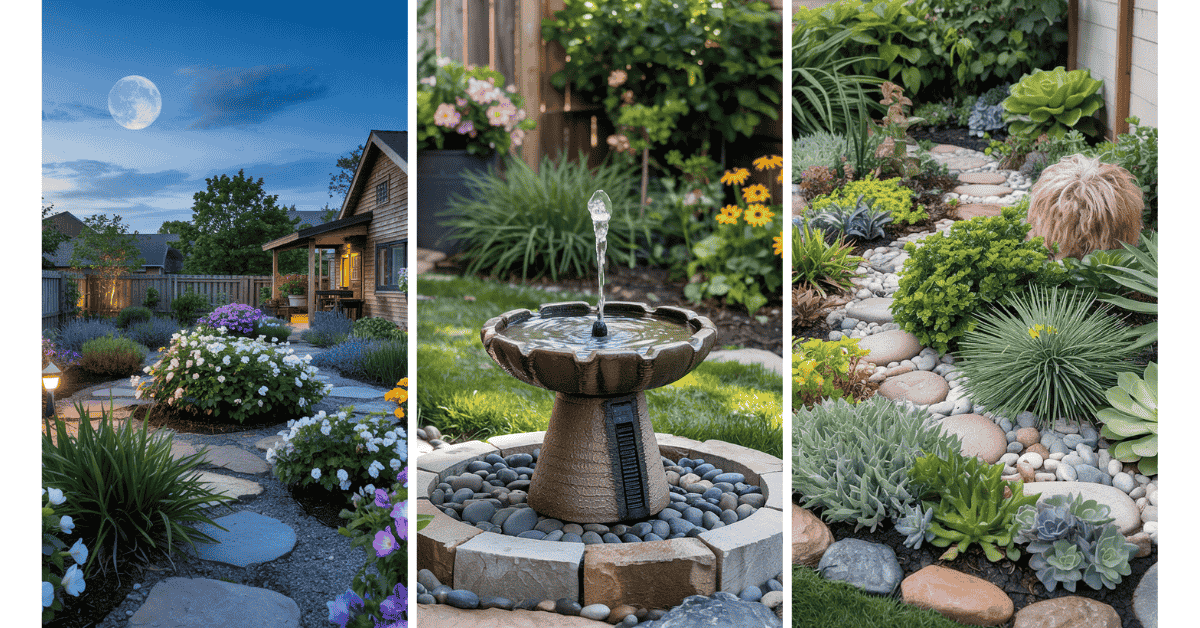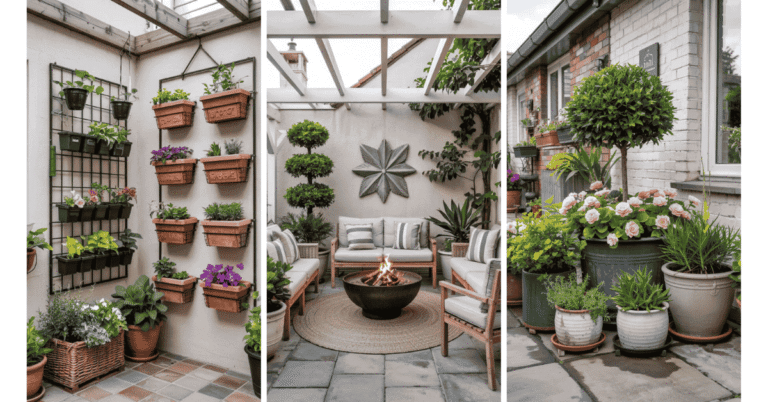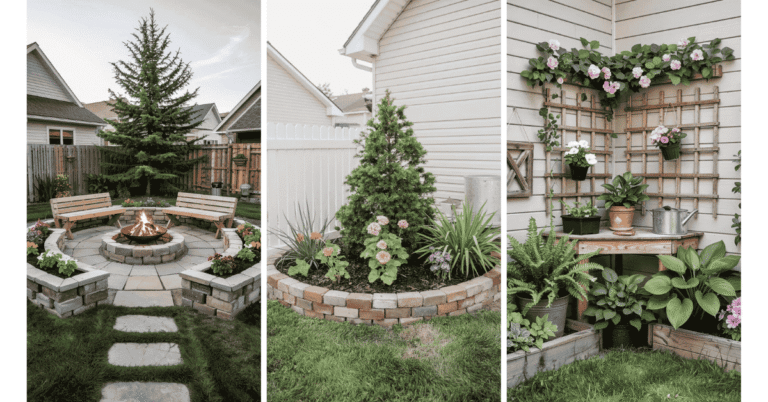16 Sensory Garden Ideas to Awaken Your Senses

I’ve always believed that a garden should be more than just something pretty to look at. The best outdoor spaces engage all five senses, creating an immersive experience that can calm the mind, lift the spirit, and reconnect us with nature.
Whether you’re working with a sprawling backyard or a compact balcony, I’m excited to share 16 sensory garden ideas that will transform your outdoor space into a haven for the senses.
Each suggestion is designed to be practical and achievable, regardless of your gardening experience.
1. Plant Fragrant Herbs Along Pathways
I always recommend placing aromatic herbs like lavender, rosemary, and mint along garden paths where you’ll brush against them as you walk. This simple placement creates natural bursts of fragrance that enhance every stroll through your garden.
These herbs are low-maintenance and drought-tolerant once established, making them perfect for busy gardeners. I’ve found that the scent alone can reduce stress levels and create a spa-like atmosphere right in your backyard.
2. Add Wind Chimes for Auditory Appeal
I love incorporating wind chimes made from different materials—bamboo, metal, or glass—to create varied soundscapes throughout the garden. Each type produces its own distinct tone, from deep resonant notes to bright tinkling sounds.
Position them at different heights and locations to create layers of sound. I’ve noticed that this auditory dimension adds depth to the garden experience and can mask unwanted noise from nearby streets or neighbors.
3. Create a Touch-and-Feel Border
I design dedicated touch borders using plants with interesting textures like lamb’s ear (soft and fuzzy), ornamental grasses (wispy and flowing), and succulents (smooth and cool). This tactile variety invites interaction and exploration.
Children especially love these sensory borders, but I’ve seen adults equally captivated by the diverse textures. I arrange plants from softest to prickliest to create a sensory journey along the border’s length.
4. Install a Small Water Feature
I’ve found that even a modest fountain or birdbath with moving water can transform a garden’s ambiance. The sound of trickling water creates a calming atmosphere and attracts birds, adding visual interest and natural sounds.
Water features don’t need to be expensive or elaborate. I’ve created stunning effects with simple solar-powered fountains that require no electrical wiring and cost under $50.
5. Grow Edible Flowers and Vegetables
I incorporate edible plants like nasturtiums, pansies, cherry tomatoes, and snap peas throughout my sensory gardens. This allows visitors to engage their sense of taste while appreciating the beauty and aroma of these plants.
There’s something magical about picking and eating food directly from your garden. I’ve watched countless guests light up when I tell them they can taste the flowers in the salad border.
6. Use Colorful Foliage for Visual Impact
I create visual interest by combining plants with diverse foliage colors—deep purples, bright chartreuses, silvery grays, and vibrant reds. This approach provides year-round color even when flowers aren’t blooming.
Coleus, heuchera, and Japanese maple are my go-to choices for dramatic foliage. I’ve learned that thoughtful color combinations can evoke different moods, from energizing to calming.
7. Include Plants That Move in the Breeze
I always add ornamental grasses and plants with delicate stems that dance in even the slightest breeze. This movement creates a dynamic, living quality that static plantings simply can’t match.
Varieties like Mexican feather grass and Japanese forest grass are particular favorites of mine. I position them where backlighting from the sun can highlight their graceful movements.
8. Design a Barefoot Path
I create textured pathways using different materials like smooth river stones, wood chips, sand, and grass. Walking barefoot along these paths provides a grounding, meditative experience that connects you directly with the earth.
Research shows that walking barefoot on natural surfaces can reduce inflammation and improve sleep quality. I’ve made my barefoot path a morning ritual that sets a positive tone for the entire day.
9. Plant Night-Blooming Flowers
I include evening-scented plants like night-blooming jasmine, moonflower, and evening primrose that release their fragrance after sunset. This extends the sensory experience into the evening hours.
Many night-bloomers have white or pale flowers that seem to glow in moonlight, creating an ethereal quality. I’ve hosted countless memorable evening gatherings around these enchanting plants.
10. Add Bird Feeders and Houses
I strategically place bird feeders and nesting boxes to attract feathered visitors whose songs and activities add life to the garden. Different feeder types attract different species, increasing diversity.
Native birds provide natural pest control while offering entertainment and connection to wildlife. I’ve identified over 15 species visiting my sensory garden throughout the year.
11. Incorporate Textured Hardscaping
I use varied hardscaping materials like rough stone, smooth concrete, weathered wood, and polished pebbles to create tactile interest beyond the plantings. These permanent features provide structure and year-round sensory appeal.
The contrast between different materials heightens awareness and encourages touch. I’ve found that children instinctively run their hands along textured walls and pathways.
12. Create Scent Zones
I organize the garden into distinct fragrance areas—a citrus corner, a rose garden, a herb spiral—so visitors experience different aromas as they move through the space. This prevents sensory overload while creating memorable transitions.
Separating strong scents allows each to be fully appreciated. I’ve learned that this zoning approach makes even small gardens feel larger and more complex.
13. Add Seasonal Interest
I plan for sensory experiences across all seasons by including spring bulbs, summer bloomers, fall foliage, and winter structure. This ensures the garden remains engaging throughout the year.
Evergreens provide winter texture and scent, while deciduous plants offer changing colors. I’ve discovered that seasonal transitions themselves become anticipated events.
14. Include a Seating Area Surrounded by Sensory Plants
I design intimate seating nooks enclosed by fragrant, textured, and visually appealing plants. This creates an immersive experience where you’re completely surrounded by sensory stimulation.
These spaces become natural meditation spots and favorite reading nooks. I’ve spent countless peaceful hours in my own sensory seating area.
15. Use Climbing Plants on Structures
I train fragrant climbers like jasmine, honeysuckle, and climbing roses on trellises, arbors, and pergolas. This adds vertical dimension while bringing scent and texture to eye level.
Vertical gardening maximizes sensory impact in limited spaces. I’ve created stunning effects even in narrow side yards using this approach.
16. Plant a Moon Garden
I dedicate a section to white and silver plants that reflect moonlight and seem to glow at dusk. Combined with night-blooming flowers, this creates a magical evening sensory experience.
Moon gardens offer a completely different perspective on your outdoor space. I’ve found that they encourage evening garden visits that would otherwise never happen.
Bottom Lines
Creating a sensory garden doesn’t require a complete landscape overhaul. I encourage you to start with just one or two ideas that resonate with you and build from there.
The beauty of sensory gardening is that there’s no single right approach—your garden should reflect what appeals to your particular senses. I’ve seen stunning sensory spaces created with limited budgets and small areas, proving that engagement, not size, matters most.
Ready to transform your outdoor space into a multi-sensory retreat? Pick your favorite idea from this list and start planning today. Your senses will thank you.An error occurred during generation. Please try again or contact support if it continues.






















